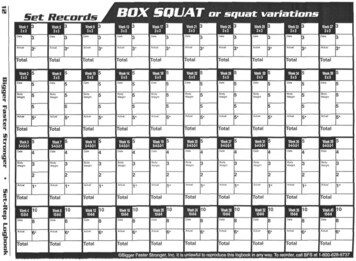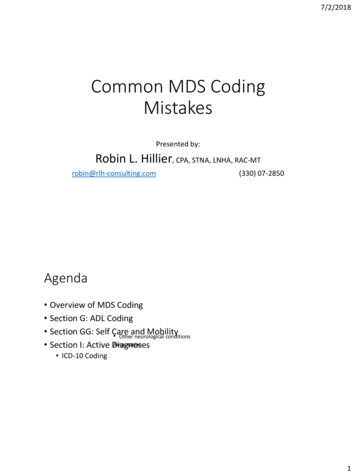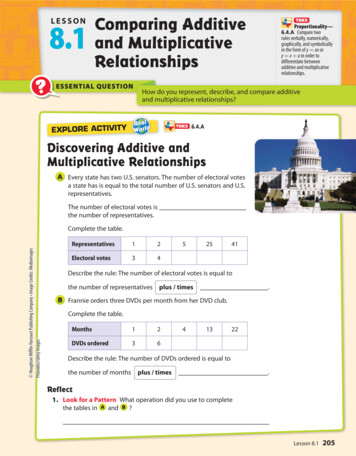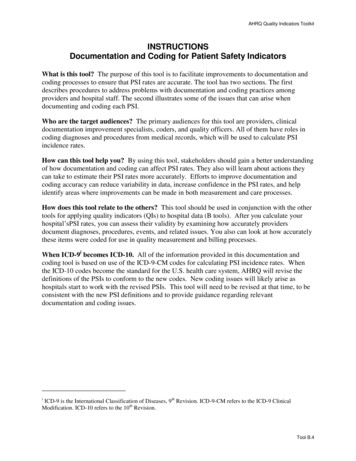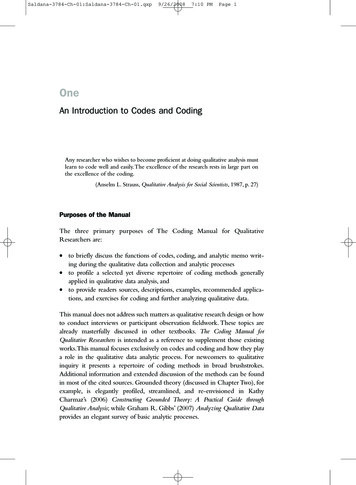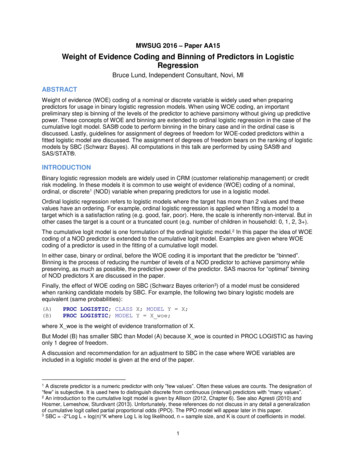
Transcription
MWSUG 2016 – Paper AA15Weight of Evidence Coding and Binning of Predictors in LogisticRegressionBruce Lund, Independent Consultant, Novi, MIABSTRACTWeight of evidence (WOE) coding of a nominal or discrete variable is widely used when preparingpredictors for usage in binary logistic regression models. When using WOE coding, an importantpreliminary step is binning of the levels of the predictor to achieve parsimony without giving up predictivepower. These concepts of WOE and binning are extended to ordinal logistic regression in the case of thecumulative logit model. SAS code to perform binning in the binary case and in the ordinal case isdiscussed. Lastly, guidelines for assignment of degrees of freedom for WOE-coded predictors within afitted logistic model are discussed. The assignment of degrees of freedom bears on the ranking of logisticmodels by SBC (Schwarz Bayes). All computations in this talk are performed by using SAS andSAS/STAT .INTRODUCTIONBinary logistic regression models are widely used in CRM (customer relationship management) or creditrisk modeling. In these models it is common to use weight of evidence (WOE) coding of a nominal,ordinal, or discrete1 (NOD) variable when preparing predictors for use in a logistic model.Ordinal logistic regression refers to logistic models where the target has more than 2 values and thesevalues have an ordering. For example, ordinal logistic regression is applied when fitting a model to atarget which is a satisfaction rating (e.g. good, fair, poor). Here, the scale is inherently non-interval. But inother cases the target is a count or a truncated count (e.g. number of children in household: 0, 1, 2, 3 ).The cumulative logit model is one formulation of the ordinal logistic model. 2 In this paper the idea of WOEcoding of a NOD predictor is extended to the cumulative logit model. Examples are given where WOEcoding of a predictor is used in the fitting of a cumulative logit model.In either case, binary or ordinal, before the WOE coding it is important that the predictor be “binned”.Binning is the process of reducing the number of levels of a NOD predictor to achieve parsimony whilepreserving, as much as possible, the predictive power of the predictor. SAS macros for “optimal” binningof NOD predictors X are discussed in the paper.Finally, the effect of WOE coding on SBC (Schwarz Bayes criterion3) of a model must be consideredwhen ranking candidate models by SBC. For example, the following two binary logistic models areequivalent (same probabilities):(A)(B)PROC LOGISTIC; CLASS X; MODEL Y X;PROC LOGISTIC; MODEL Y X woe;where X woe is the weight of evidence transformation of X.But Model (B) has smaller SBC than Model (A) because X woe is counted in PROC LOGISTIC as havingonly 1 degree of freedom.A discussion and recommendation for an adjustment to SBC in the case where WOE variables areincluded in a logistic model is given at the end of the paper.A discrete predictor is a numeric predictor with only ”few values”. Often these values are counts. The designation of“few” is subjective. It is used here to distinguish discrete from continuous (interval) predictors with “many values”.2 An introduction to the cumulative logit model is given by Allison (2012, Chapter 6). See also Agresti (2010) andHosmer, Lemeshow, Sturdivant (2013). Unfortunately, these references do not discuss in any detail a generalizationof cumulative logit called partial proportional odds (PPO). The PPO model will appear later in this paper.3 SBC -2*Log L log(n)*K where Log L is log likelihood, n sample size, and K is count of coefficients in model.11
TRANSFORMING BY WOE FOR BINARY LOGISTIC REGRESSIONA NOD predictor C (character or numeric) with L levels can be entered into a binary logistic regressionmodel with a CLASS statement or as a collection of dummy variables. 4 Typically, L is 15 or less.PROC LOGISTIC; CLASS C; MODEL Y C and other predictors ;orPROC LOGISTIC; MODEL Y C dum k where k 1 to L-1 and other predictors ;These two models produce exactly the same probabilities.An alternative to CLASS / DUMMY coding of C is the weight of evidence (WOE) transformation of C.It is notationally convenient to use Gk to refer to counts of Y 1 and Bk to refer to counts of Y 0 whenC Ck. Let G k Gk. Then gk is defined as gk Gk / G. Similarly, for bk. For the predictor C and target Yof Table 1 the weight of evidence transformation of C is given by the right-most column in the table.Table 1. Weight of Evidence Transformation for Binary Logistic RegressionCC1C2C3Y 0“Bk”215Y 1“Gk”116Col % Y 0“bk”0.2500.1250.625Col % Y 1“gk”0.1250.1250.750WOE Log(gk/bk)-0.693150.000000.18232The formula for the transformation is: If C “Ck” then C woe log (gk / bk) for k 1 to L where gk, bk 0.WOE coding is preceded by binning of the levels of predictor C, a topic to be discussed in a later section.A Property of a Logistic Model with a Single Weight of Evidence PredictorWhen a single weight of evidence variable C woe appears in the logistic model:PROC LOGISTIC DESCENDING; MODEL Y C woe;then the slope coefficient equals 1 and the intercept is the log (G/B). This property of a woe-predictor isverified by substituting the solution α log (G/B) and β 1 into the maximum likelihood equations to showthat a solution has been found. This solution is the global maximum since the log likelihood function has aunique extreme point and this point is a maximum (ignoring the degenerate cases given by data setshaving quasi-complete and complete separation). See Albert and Anderson (1984, Theorem 3).Information Value of C for Target YAn often-used measure of the predictive power of predictor C is Information Value (IV). It measurespredictive power without regard to an ordering of a predictor. The right-most column of Table 2 gives theterms that are summed to obtain the IV. The range of IV is the non-negative numbers.Table 2. Information Value Example for Binary Logistic RegressionCC1C2C3SUMY 0“Bk”2158Y 1“Gk”1168Col % Y 0“bk”0.2500.1250.625Col % Y .18232gk - bk-0.12500.125IV IV Terms(gk - bk) * Log(gk/bk)0.086640.000000.022790.10943IV can be computed for any predictor provided none of the gk or bk is zero. As a formula, IV is given by:IV k 1L (gk – bk) * log (gk / bk)where L 2 and where gk and bk 0 for all k 1, , L“CLASS C;” creates a coefficient in the model for each of L-1 of the L levels. The modeler’s choice of “referencelevel coding” determines how the Lth level enters into the calculation of the model scores. See SAS/STAT(R) 14.1User's Guide (2015), LOGISTIC procedure, CLASS statement.42
Note: If two levels of C are collapsed (binned together), the new value of IV is less than or equal to the oldvalue. The new IV value is equal to the old IV value if and only if the ratios g r / br and gs / bs are equal forlevels Cr and Cs that were collapsed together.5Predictive Power of IV for Binary Logistic RegressionGuidelines for interpretation of values of the IV of a predictor in an applied setting are given below. Theseguidelines come from Siddiqi (2006, p.81). 6 In logistic modeling applications it is unusual to see IV 0.5.Table 3. Practical Guide to Interpreting IVIV RangeIV 0.02IV in [0.02 to 0.1)IV in [0.1 to 0.3)IV 0.3Interpretation“Not re is a strong relationship of the IV of predictor C to the Log Likelihood (LL) of the model:PROC LOGISTIC; CLASS C; MODEL Y C;For example, if N 10,000 and L 5, then a simple linear regression of IV to LL is a good model. Basedon a simulation (with 500 samples) the R-square is 61%.7Before a predictor is converted to WOE coding and is entered into a model, the predictor should undergoa binning process to reduce the number of levels in order to achieve parsimony but while maintainingpredictive power to the fullest extent possible. This important topic is discussed in a later section.The next step is to explore the extension of weight of evidence coding and information value to the caseof ordinal logistic regression and, in particular, to the cumulative logit model.CUMULATIVE LOGIT MODELIf the target variable in PROC LOGISTIC has more than 2 levels, PROC LOGISTIC regards theappropriate model as being the cumulative logit model with the proportional odds property. 8 Anexplanation of the cumulative logit model and of the proportional odds property is given in this section.A Simplification for This PaperIn this paper all discussion of the cumulative logit model will assume the target has 3 levels. This reducesnotational complexity. The concept of weight of evidence for the cumulative logit model does not dependon having only 3 levels. But the assumption of 3 levels does provide crucial simplifications when applyingthe weight of evidence approach to examples of fitting cumulative logit models, as will be seen later in thepaper.Definition of the Cumulative Logit Model with the Proportional Odds (PO) PropertyTo define the cumulative logit model with PO, the following example is given: Assume the 3 levels for theordered target Y are A, B, C and suppose there are 2 numeric predictors X1 and X2.9Let pk,j probability that the kth observation has the target value j A, B or CThen the cumulative logit model has 4 parameters αA αB βX1 βX2 and is given via 2 response equations:Log (pk,A / (pk,B pk,C)) αA βX1*Xk,1 βX2*Xk,2Log ((pk,A pk,B) / pk,C) αB βX1*Xk,1 βX2*Xk,2 response equation j A response equation j BThe coefficients βX1 and βX2 of predictors X1 and X2 are the same in both response equations.5See Lund and Brotherton (2013, p. 17) for a proof.See Siddiqi (2006) for the usage of WOE and IV in the preparation of predictors for credit risk models7 This simulation code is available from the author. See Lund and Brotherton (2013) for more discussion.8 Simply run: PROC LOGISTIC; MODEL Y X’s ; where Y has more than 2 levels.9 If a predictor X is not numeric, then the dummy variables from the coding of the levels of X appear in the right-handside of the response equations for j A and j B.63
The “cumulative logits” are the log of the ratio of the “cumulative probability to j” (in the ordering of thetarget) in the numerator to “one minus the cumulative probability to j” in the denominator.Formulas for the probabilities pk,1, pk,2, pk,3 can be derived from the two response equations. To simplifythe formulas, let Tk and Uk, for the kth observation be defined by the equations below:Let Tk exp (αA βX1*Xk,1 βX2*Xk,2)Let Uk exp (αB βX1*Xk,1 βX2*Xk,2)Then, after algebraic manipulation, these probability equations are found:Table 4. Cumulative Logit Model - Equations for ProbabilitiesResponseABCProbability Formulapk,A 1 - 1/(1 Tk)pk,B 1/(1 Tk) - 1/(1 Uk)pk,C 1/(1 Uk)The parameters for the cumulative logit model are found by maximizing the log likelihood equation in amanner similar to the binary case.10This cumulative logit model satisfies the following conditions for X1 (and the analogous conditions for X2):Let “r” and “s” be two values of X1. Using the probability formulas from Table 4:Log [Log [prA (prB prC )psA (psB psC )] Log (pr,A / (pr,B pr,C)) - Log (ps,A / (ps,B ps,C)) (r - s) * βX1 proportional odds(prA prB ) prC(psA psB ) psC] Log ((pr,A pr,B) / pr,C) - Log ((ps,A ps,B) / ps,C) (r - s) * βX1 proportional oddsThese equations display the “proportional odds” property. Specifically, the difference of cumulative logitsat r and s is proportional to the difference (r - s). The proportional odds property for X1 is a by-product ofassuming that the coefficients of predictor X1 are equal across the cumulative logit response equations.EXTENDING WOE TO CUMULATIVE LOGIT MODELThere are two defining characteristics of the weight of evidence coding, X woe, of a predictor X when thetarget is binary and X woe is the single predictor in a logistic model. These are:1. Equality of Model (I) and Model (II):(I) PROC LOGISTIC DESCENDING; CLASS X; MODEL Y X;(II) PROC LOGISTIC DESCENDING; MODEL Y X woe;2. The values of the coefficients for Model (II): Intercept Log (G / B) and Slope 1GOAL: Find a definition of WOE to extend to the cumulative logit model so that the appropriategeneralizations of (1) and (2) are true.WOE TRANSFORMATIONS FOR THE CUMULATIVE LOGIT MODELAfter trial and error, when trying to define an extension of weight of evidence coding of X for thecumulative logit model, I realized that if Y had L levels, then L-1 WOE transformations were needed.The extension of WOE to the cumulative logit model does not require an assumption of proportional odds.Consider an ordinal target Y with levels A, B, C and predictor X with levels 1, 2, 3, 4. Here, Y has 3 levelsand, therefore, 2 weight of evidence transformations are formed.The two tables below illustrate the steps to define the weight of evidence transformation for X. The firststep is to define two sets of column percentages corresponding to the two cumulative logits.10See Agresti (2010, p 58).4
Table 5. Defining WEIGHT OF EVIDENCE Predictors for Cumulative Logit Model – STEP 1X i1234TotalAi244111Y Bi13127Ci212510Col %Col %(Bi Ci) / (B C)(Ai Bi) / (A re A Ai, B Bi, C CiAi / A0.182Ci / C0.200.100.200.50For the first cumulative logit the value 0.182 in column “A1 / A” is equal to 2 divided by 11. The value0.176 in column “(B1 C1) / (B C)” is equal to 1 2 divided by 7 10. Similarly, the columns for thesecond cumulative logit are computed.Now, the second step:Table 6. Defining WEIGHT OF EVIDENCE Predictors for Cumulative Logit Model – STEP 2Y X iAiBi Ci21243441Total 111 23 11 22 57 10Col %(Bi Ci) /Ai / A(B C)0.182 0.1760.360.240.360.180.090.41Col %Ratio of Col %(Ai Bi) /A overA BCi / C(A B)B Cover .390.170.500.220.33Where A Ai, B Bi, C CiLog (Ratio)X WOE1X WOE20.030.440.72-1.51-0.181.360.33-1.10The “ratio of column percentages” for the first row of the first cumulative logit is computed by 1.034 0.182 / 0.176. The log of this ratio gives the weight of evidence for the first row of 0.03. Likewise, the firstrow for the second weight of evidence is -0.18.As equations:X WOE1 (X i) LOG [(Ai / A) / ((Bi Ci) / (B C))]X WOE2 (X i) LOG [((Ai Bi) / (A B)) / (Ci / C)]Although X in this example is numeric, a character predictor may take the role of X.Cumulative Logit Model with Proportional Odds Does Not Support a Generalization of WOETable 6 is converted to the data set EXAMPLE1 in Table 7 for the same predictor X and 3-level ordinaltarget Y. The use of the EXAMPLE1 will show that the cumulative logit PO model does not support therequired two characteristics for a WOE predictor.Table 7. Data Set EXAMPLE1 for Illustrations to FollowDATA EXAMPLE1; Input X Y @@; Datalines;1 A 2 A 3 A 4 B1 A 2 A 3 A 4 B1 B 2 B 3 A 4 C1 C 2 B 3 B 4 C1 C 2 B 3 C 4 C2 A 2 C 3 C 4 C2 A 3 A 4 A 4 C;To show the failure of the WOE definitions in the cumulative logit PO case, the Models (I) and (II) areconsidered:(I) PROC LOGISTIC DATA EXAMPLE1; CLASS X; MODEL Y X;(II) PROC LOGISTIC DATA EXAMPLE1; MODEL Y X woe1 X woe2;The reader may verify the Models (I) and (II) do not produce the same probabilities. In addition, thecoefficients of Model (II) do not have the required values.5
Table 8. Results of MODEL (II)Maximum Likelihood ptB0.7067X Woe10.6368X Woe20.2869Not Equal to: -0.4353 0.5878 1 1 Log(A/(B C)) Log((A B)/C)A generalization of the PO model is needed in order to generalize the idea of weight of evidence coding.The next section describes the partial proportional odds (PPO) cumulative logit model and how weight ofevidence can be generalized to this setting.Partial Proportional Odds (PPO) Cumulative Logit ModelTo describe the PPO cumulative logit model, the following simple example is given: Assume there are 3levels for the ordered target Y: A, B, C and suppose there are 3 numeric predictors R, S and Z.Let pk,j probability that kth observation has the target value j A, B or CIn this case the PPO Model has 6 parameters α1 α2 βR βS βZ1 βZ2 given in 2 equations:Log (pk,A / (pk,B pk,C)) αA βR*Rk βS*Sk βZ,A*Zk j ALog ((pk,A pk,B) / pk,C) αB βR*Rk βS*Sk βZ,B*Zk j BThe coefficients of the predictors βR and βS are the same in the 2 equations but βZj varies with j. There are4 β’s in total.The formulas for the probabilities pk,A, pk,B, pk,C continue to be given by Table 4 after modifications to thedefinitions of T and U to reflect the PPO model.Weight of Evidence in the Setting of PPO Cumulative Logit ModelModels (I) and (II) are modified to allow the coefficients of the predictors to depend on the cumulative logitresponse function. This is accomplished by adding the UNEQUALSLOPES statement.(I) PROC LOGISTIC DATA EXAMPLE1; CLASS X;MODEL Y X / unequalslopes (X);(II) PROC LOGISTIC DATA EXAMPLE1;MODEL Y X woe1 X woe2 / unequalslopes (X woe1 X woe2);For data set EXAMPLE1, Models (I) and (II) are the same model (produce the same probabilities).Model (II) produces coefficients which generalize WOE coefficients from the binary case. Formulas forthese coefficients are shown below:α1 log (nA / (nB nC)) α2 log ((nA nB) / nC)βX woe1,1 1, βX woe1,2 0;βX woe2,1 0, βX woe2,2 1; (*)where nA is count of Y A, nB is count of Y B, nC is count of Y CThe regression results from running Model (II) are given in Table 9.Table 9. Results of MODEL (II)Maximum Likelihood ptB0.5878X Woe1A1.0000X Woe1B-127E-12X Woe2A3.2E-10X Woe2B1.0000Equal to:-0.43530.58781001 Log(A/(B C)) Log((A B)/C)6
Conclusion Regarding the Usage of Weight of Evidence PredictorsWeight of evidence predictors should enter a cumulative logit model with the unequalslopes parameter inorder to reproduce the 2 defining characteristics of the weight of evidence predictor from the binary case.CommentsThere are degenerate {X, Y} data sets where a cumulative logit model has no solution.11 Setting thesecases aside, I do not have a solid mathematical proof that coefficients, as given by (*), always producethe maximum likelihood solution for Model (II) or that Model (I) and Model (II) are always equivalent. I amrelying on verification by examples.Using the parameter values found for Model (II) the probabilities for target levels A, B, and C are obtainedby substitution into the equations in Table 4.pr,A Ar / (Ar Br Cr)pr,B Br / (Ar Br Cr)pr,C Cr / (Ar Br Cr)where Ar is the count of Y A when X r, etc.EXAMPLE: BACKACHE DATA, LOG OF AGE, AND SEVERITY WITH THREE LEVELSA paper by Bob Derr (2013) at the 2013 SAS Global Forum discussed the cumulative logit PO and PPOmodels. In the paper Derr studied the log transform of the AGE (called LnAGE) of pregnant women whohave one of 3 levels of SEVERITY of backache in the “BACKACHE IN PREGNANCY” data set fromChatfield (1995, Exercise D.2). Using a statistical test called OneUp Derr shows it is reasonable to useunequalslopes for LnAGE when predicting SEVERITY.There is a data set called BACKACHE in the Appendix with 61 observations which expands to 180 afterapplying a frequency variable. It has AGE and SEVERITY (and a frequency variable FREQ ) from theBACKACHE IN PREGNANCY data set. See this data set for the discussion that follows below.The weight of evidence transforms of AGE will be used in a PPO model for SEVERITY and will becompared with the results of running a cumulative logit model for LnAGE with unequalslopes.The logistic model for SEVERITY with unequalslopes for LnAGE gives the fit statistics in Table 10a andTable 10b.PROC LOGISTIC DATA Backache;MODEL SEVERITY LnAGE / unequalslopes LnAGE;Freq freq ;run;Table 10a. SEVERITY from Backache Data Predicted by LnAGE with UnequalslopesCriterionAICSC-2 Log LModel Fit StatisticsIntercept OnlyIntercept and 23Table 10b. SEVERITY from Backache Data Predicted by LnAGE with UnequalslopesTesting Global Null Hypothesis: BETA 0TestChi-SquareDFPr ChiSqLikelihood 255Replacing LnAGE by Weight of EvidenceWhat improvement in fit might be achieved by replacing LnAGE with AGE woe1 and AGE woe2?11Agresti (2010 p. 64)7
This is explored next.The AGE * SEVERITY cells have zero counts when AGE 19, AGE 22, and AGE 32. To eliminatethese zero cells, AGE levels were collapsed as shown. AGE had 13 levels after this preliminary binning.DATA Backache2; Set Backache;if AGE 19 then AGE 19;if AGE 22 then AGE 23;if AGE 32 then AGE 32;Next, AGE woe1 and AGE woe2 were computed. Before entering AGE woe1 and AGE woe2 into theMODEL their correlation should be checked. The correlation of AGE woe1 and AGE woe2 was found tobe 58.9% which is suitably low to support the use of both predictors in a model.Now the PPO model, shown below, was run;PROC LOGISTIC DATA Backache2;MODEL SEVERITY AGE woe1 AGE woe2 / unequalslopes (AGE woe1 AGE woe2);Freq freq ;run;The fit was improved, as measured by -2 * Log L, from 349.423 to 336.378 as seen in Table 11a.Table 11a. SEVERITY from Backache Data Predicted by WOE recoding of LnAGE with UnequalslopesCriterionAICSC-2 Log LModel Fit StatisticsIntercept OnlyIntercept and 78Penalized Measures of Fit Instead of Log-LikelihoodBut the measures AIC and SC (Schwarz Bayes criterion) of parsimonious fit of 348.378 and 367.536 arenot correctly computed when weight of evidence predictors appear in a model. The weight of evidencepredictors should count for a total of 24 degrees of freedom and not the 4 counted by PROC LOGISTIC,as shown in the Testing Global Null Hypothesis report, Table 11b.Table 11b. SEVERITY from Backache Data Predicted by WOE recoding of LnAGE with UnequalslopesTesting Global Null Hypothesis: BETA 0TestChi-SquareDFPr ChiSqLikelihood 0.0004The penalized measures of fit, AIC and SC should be recomputed to match the Model Fit Statistics for theequivalent model with a CLASS statement for AGE shown below in Table 12.PROC LOGISTIC DATA Backache2;CLASS AGE;MODEL SEVERITY AGE / unequalslopes (AGE);Freq freq ;run;Table 12. Model Fit Statistics with Adjusted Degrees of FreedomCriterionAICSC-2 Log LModel Fit Statistics (adjusted)Intercept OnlyIntercept and 78The adjusted SC of 471.395 is much higher than the SC of 370.194 from the PPO model with LnAGE.Similarly, the adjusted AIC of 388.378 is much higher than the 357.423 from the PPO model with LnAGE.8
BINNING PREDICTORS FOR CUMULATIVE LOGIT MODELSThe weight of evidence predictors AGE WOE1 and AGE WOE2 use the 13 levels of AGE. Perhapsthese 13 levels could be binned to a smaller number to achieve parsimony and still retain most of thepredictive power?For logistic models with binary targets there are methods to decide which levels of the predictor tocollapse together, at each step, so as to maximize the remaining predictive power. These measuresinclude: (i) Information Value, (ii) Log Likelihood (equivalent to entropy), (iii) p-value from the chi-squaremeasure of independence of X and the target. (The Interactive Grouping Node (IGN) in SAS EnterpriseMiner provides the user with the choice of either (ii) or (iii) when binning predictors and IGN reports the IVfor each binning solution.)How can these binary methods be generalized to binning decisions for the cumulative logit model?For the cumulative logit model, the use of Information Value for binning is complicated because eachweight of evidence predictor has its own IV. One approach for binning decisions is to compute TOTAL IVby simply summing the individual IV’s.A work-in-progress macro called %CUMLOGIT BIN is being developed to perform binning in the case ofthe cumulative logit model. For this macro the target has L 2 ordered values and the predictor X may benumeric or character.Two input parameters for %CUMLOGIT BIN are: MODE: The user first decides which pairs of levels of the predictor X are eligible for collapsingtogether. The choice is between “any pairs are eligible” or “only adjacent pairs in the ordering of X”. METHOD: This is a criterion for selecting the pair for collapsing. The choices are TOTAL IV andENTROPY. For TOTAL IV the two levels of the predictor which give the greatest TOTAL IV aftercollapsing (versus all other choices) are the levels which are collapsed at that step. A similardescription applies if ENTROPY is selected.%CUMLOGIT BIN APPLIED TO AGE AND SEVERITY FROM BACKACHETOTAL IV and adjacent-only collapsing were selected for %CUMLOGIT BIN and applied to AGE fromthe Backache data set. There were 13 levels for AGE after the initial zero cell consolidation.The summary results of the binning are shown in Table 13.The AIC and SC columns have been adjusted for degrees of freedom for weight of evidence. If AIC andSC are not a concern for predictor variable preparation before modeling, then either a 10-bin or 9-binsolution has appeal since TOTAL IV begins to fall rapidly thereafter. These solutions give -2 * Log Lvalues of 336.60 and 336.92 in comparison with 349.423 for LnAGE (Table 10). The correlations betweenAGE woe1 and AGE woe2 are moderate for the solutions with 10-bins and 9-bins (63% and 68%).Table 13. Binning of AGE vs. SEVERITY from BACKACHE DATA. MODE ADJACENT, Method TOTAL IVBINS1312111098765432MODEL DFWith Intercept262422201816141210864-2 341.54344.50345.34348.01IV 10.1080.049IV 30.4090.382Total 640.5170.4309Adj. 4361.54360.50357.34356.01Adj 393.47386.04376.50368.78Correlation ofAGE woe1 andAGE 820.80750.88270.99961.0000
The selection of either the 10-bin or 9-bin WOE solution, in conjunction with all the other predictors ofSEVERITY, is likely to provide an improvement in the complete Backache Model versus the usage ofLnAGE with unequalslopes.PREDICTORS WITH EQUAL SLOPESFor the cumulative logit model example of AGE and SEVERITY the predictor LnAGE was judged to haveunequal slopes according to the OneUp test. When using 13 bins for AGE the weight of evidencevariables, AGE woe1 and AGE woe2, were only moderately correlated.What about the case of “equal slopes“? If a target Y has three levels and a predictor X has equal slopes,can X woe1 and X woe2 still be used to replace X? The answer is “Yes” unless X woe1 and X woe2are too highly correlated.The DATA Step creates data for a cumulative logit model where the target has 3 levels, the predictor Xhas 8 levels, and X has equal slopes. In the simulation code the slopes of X are set at 0.1 (see thestatements for T and U).DATA EQUAL SLOPES;do i 1 to 800;X mod(i,8) 1;T exp(0 0.1*X 0.01*rannor(1));U exp(1 0.1*X 0.01*rannor(3));PA 1 - 1/(1 T);PB 1/(1 T) - 1/(1 U);PC 1 - (PA PB);R ranuni(5);if R PA then Y "A";else if R (PA PB) then Y "B";else Y "C";output;end;run;The OneUp test for X has a p-value of 0.56 and the null hypothesis of equal slopes is accepted.The results for the cumulative logit PO model for X with target Y are shown in Table 14. The fit is givenby -2 * Log L 1463.462 and the estimated slope for X is 0.1012 with Pr ChiSq 0.0012.PROC LOGISTIC DATA EQUAL SLOPES;MODEL Y X;run;Table 14. The Cumulative Logit PO Model for X and Target YCriterionAICSC-2 Log LParameterInterceptInterceptXModel Fit StatisticsIntercept OnlyIntercept and 1463.462Analysis of Maximum Likelihood EstimatesDFEstimateStd. ErrorWald 10120.031410.4179Pr ChiSq0.6831 .00010.0012%CUMLOGIT BIN was run on X from the data set EQUAL SLOPES to form weight of evidencepredictors X woe1 and X woe2 before any binning (X still has 8 levels).The correlation of X woe1 and X woe2 at 74.5% is near or at the borderline of being too high for bothpredictors to be entered into the model.10
Fit statistics for the PPO model with X woe1 and X woe2 and for two alternative models are given inTable 15. Each of these models has a better value of -2 * Log L than the MODEL Y X of Table 14 but atthe cost of increased degrees of freedom.But I do not know how to assign the exact degrees of freedom to the bottom two models.Table 15. Weight of Evidence Models for X and Target YModelPPO model with X woe1 and X woe2PPO model with X woe1PO model with X woe1-2 Log L1450.3981459.3491459.683MODEL DF with Intercept16?High Correlation of X woe1 and X woe2Conjecture: If X is a strong predictor, then the correlation of X woe1 and X woe2 is high.A plausibility argument for this claim is given in the Appendix. In this plausibility argument, the meaning of“strong” is left vague.The preceding example supports this conjecture since X had a strongly significance chi-square with pvalue of 0.0012 while the correlation of X woe1 and X woe2 was high at 74.5%.Observation: As the number of bins during the binning process for X approaches 2 the correlation ofX woe1 and X woe2 becomes high. This is based on my empirical observations. For two bins, X woe1and X woe2 are collinear.CUMULATIVE LOGIT MODELS: MORE TO DOWhat We Know about the Case Where the Target has Three LevelsIn the case of a target with 3 levels and predictor X, the usage of X woe1 and X woe2 in place of X in aPPO model is very likely to provide more predictive power than X or some transform of X.The process of b
Predictive Power of IV for Binary Logistic Regression Guidelines for interpretation of values of the IV of a predictor in an applied setting are given below. These guidelines come from Siddiqi (2006, p.81).6 In logistic modeling applications it is unusual to see IV 0.5. Table 3. Practical Guide to Interpreting IV IV Range Interpretation
